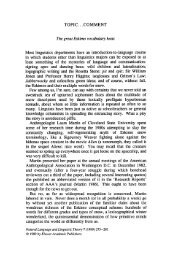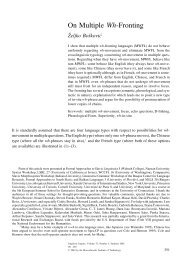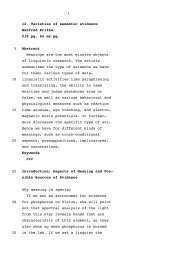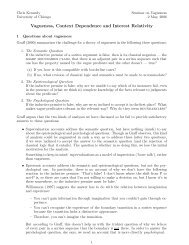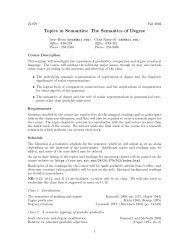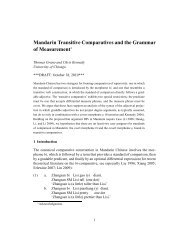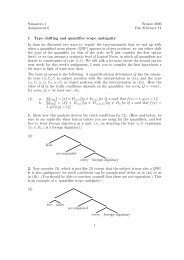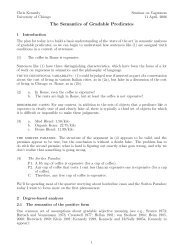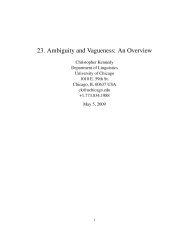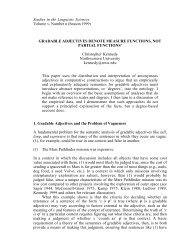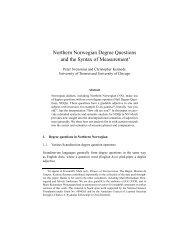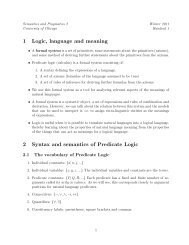On the natural history of negative polarity items - Syntax, Semantics ...
On the natural history of negative polarity items - Syntax, Semantics ...
On the natural history of negative polarity items - Syntax, Semantics ...
Create successful ePaper yourself
Turn your PDF publications into a flip-book with our unique Google optimized e-Paper software.
Sigrid Beck, Vera Hohaus & Sonja Tiemann<br />
A Note on Phrasal Comparatives<br />
Introduction. This paper investigates <strong>the</strong> semantics that a comparative operator combining<br />
with a than-phrase (as opposed to a than-clause) should have. In a recent paper, Bhatt &<br />
Takahashi (to app.) make a strong case in favor <strong>of</strong> Hindi having a particular phrasal -er<br />
morpheme and against English having this same operator. There are however fur<strong>the</strong>r<br />
suggestions for phrasal -er morphemes and <strong>the</strong>ir semantics in <strong>the</strong> literature, cf. e.g. Kennedy<br />
(1997). We compare <strong>the</strong> predictions that <strong>the</strong> different operators lead to and argue, on <strong>the</strong> basis<br />
<strong>of</strong> crosslinguistic and language acquisition data, that it has to be decided on a case-by-case<br />
basis which operator(s) a particular language employs.<br />
Background. In <strong>the</strong> analysis <strong>of</strong> a comparative sentence like (1), choices abound regarding <strong>the</strong><br />
semantic nature <strong>of</strong> <strong>the</strong> than-constituent and consequently, <strong>the</strong> comparative operator -er. For<br />
example, <strong>the</strong> than-constituent could really be a reduced clause. In that case, <strong>the</strong> Logical Form<br />
(LF) could look as in (2a), employing <strong>the</strong> operator in (2b), cf. e.g. von Stechow (1984).<br />
(1) Mary is smarter than John.<br />
(2) a. [ [ -er than how1 John is t1 smart] [2 [ Mary is t2 smart] ] ]<br />
b. [[ -er ]] = !D. !D’. max(D’) > max(D)<br />
Two Different Phrasal Comparative Operators. The first possibility for an individual<br />
phrasal -er goes back to Heim (1985) and has recently been discussed by Bhatt & Takahashi<br />
(B&T). Its semantics is in (4). The example in (1) receives <strong>the</strong> analysis in (5).<br />
(4) [[ -erphr1 ]] = !x.!R.!y. max(!d.R(d)(y)) > max(!d.R(d)(x))<br />
(5) [ Mary [ [ -er than John ] [ 1 [ 2 [ t1 is t2 smart ] ] ] ] ]<br />
This comparative operator is mobile at <strong>the</strong> level <strong>of</strong> LF and hence versatile. It can be used to<br />
analyze attributive and adverbial comparatives, and it interacts with o<strong>the</strong>r quantificational<br />
elements. There are however o<strong>the</strong>r proposals in <strong>the</strong> literature for phrasal -er morphemes and<br />
<strong>the</strong>ir semantics in <strong>the</strong> literature, e.g. Kennedy (1997):<br />
(6) [[ -erphr2 ]] = !R. !x. !y. max(!d.R(d)(y)) > max(!d.R(d)(x))<br />
B&T’s operator is schoenfinkeled differently from (6). In order to get an interpretable LF, <strong>the</strong><br />
comparative operator toge<strong>the</strong>r with its first argument, <strong>the</strong> than-phrase, undergoes movement.<br />
Notice that <strong>the</strong> lexical entry in (6) by contrast is such that it will never be able to undergo<br />
movement: (7) specifies <strong>the</strong> abstract LF required for -erphr2. Its sister must be a relational<br />
adjective type constituent, " in (7). It combines with a type than-phrase next, followed by<br />
ano<strong>the</strong>r type expression, DPx. This is not a problem with predicative adjectives, where<br />
<strong>the</strong> surface structure provides <strong>the</strong> required constituents in <strong>the</strong> required order. But when we try<br />
to create such an LF by movement, we fail, cf. (8). Creating a constituent <strong>of</strong> type



